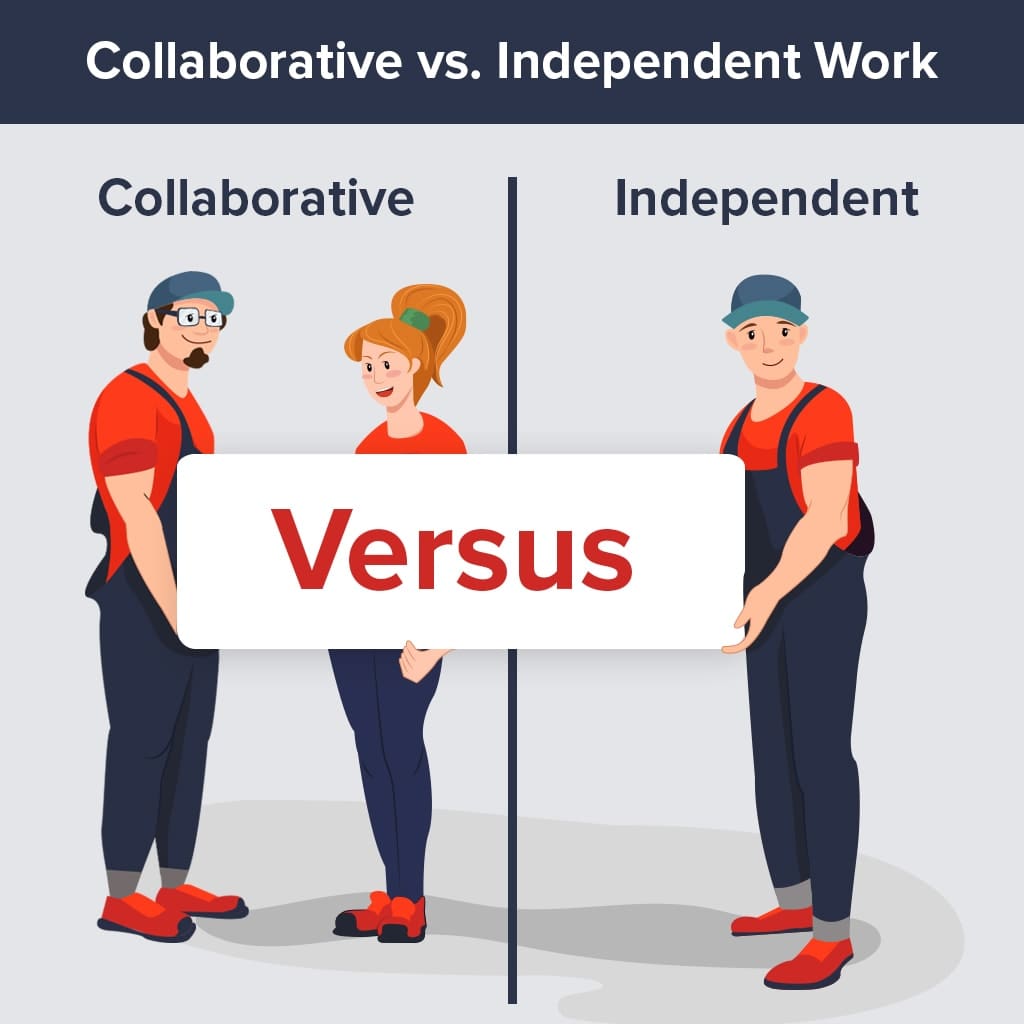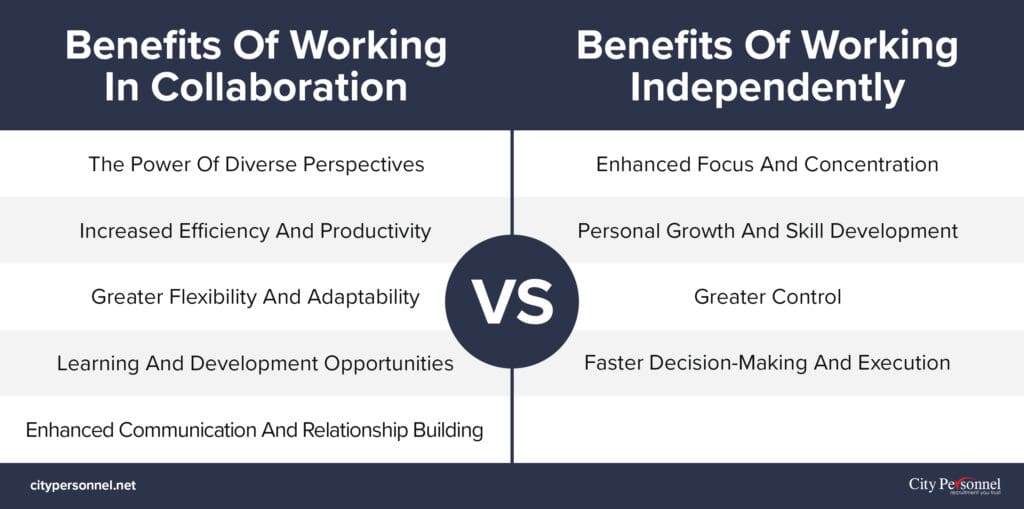In today’s fast-paced business world, the debate between collaborative and independent work methods continues to gain traction. While some people thrive in a team environment, others prefer to work independently. As employers strive to create a productive workplace, it’s essential to understand the benefits and drawbacks of each approach.
In this blog post, we will dive into the differences between collaborative and individual work, their respective strengths and weaknesses, as well as discuss ways to boost organizational productivity with each approach. With a better understanding of collaboration versus independent work, businesses can then make more informed decisions about how they run operations at their company.
Defining Collaborative and Independent Work
Collaborative work involves the joint effort of two or more individuals to achieve a common goal. It is a process in which people share their talents, skills, and ideas to produce a cohesive outcome. By working together, collaborators can leverage their strengths while mitigating their limitations.
Meanwhile, independent work requires an individual to carry out a task or project without any assistance from others. It is a process that allows an individual to take control of their work and take full responsibility for their results. Both collaborative and independent work have their advantages and disadvantages, and the context of the project will often determine which approach is more suitable.

Benefits of Working In Collaboration
Working in collaboration with others has several benefits that can help you get things done faster, with better quality, and with less stress.
The Power of Diverse Perspectives
One of the most significant benefits of working in collaboration is the opportunity to tap into a diverse range of perspectives and ideas. When team members from different backgrounds, experiences, and skill sets come together, they can generate innovative solutions that might have been overlooked in an independent work setting. This diversity of thought can lead to more comprehensive problem-solving, as well as foster creativity and innovation within the organization.
Increased Efficiency and Productivity
Collaborative work environments often result in increased efficiency and productivity. When multiple individuals pool their resources and knowledge, tasks can be completed more quickly and accurately. This can lead to a higher quality of work and a greater sense of accomplishment for team members. Moreover, working together allows employees to share the workload, which can prevent burnout and boost overall job satisfaction.
Enhanced Communication and Relationship Building
Working in collaboration encourages open communication and fosters strong working relationships among team members. As employees collaborate on projects, they develop a deeper understanding of each other’s strengths, weaknesses, and working styles. This mutual understanding can lead to improved communication, trust, and camaraderie within the team, ultimately creating a more positive and supportive work environment.
Learning and Development Opportunities
Collaborative work environments also offer unique opportunities for learning and development. As employees work together, they can share their knowledge and expertise, allowing others to learn new skills and techniques. So it’s important to create proper channels of communication, which facilitates this process. This continuous exchange of information can help employees grow both professionally and personally, increasing their value to the organization and enhancing their career prospects.
Greater Flexibility and Adaptability
Finally, collaboration can lead to greater flexibility and adaptability within the workplace. Teams that work well together are often more capable of adjusting to changes and overcoming challenges. By pooling their resources and supporting one another, collaborative teams can quickly adapt to new circumstances, making the organization more resilient in the face of change and uncertainty.
Working in collaboration offers numerous advantages for organizations and employees alike. From fostering creativity and innovation to promoting open communication and strong relationships, collaborative work environments can lead to increased productivity and overall job satisfaction. It is also important to note that about 75% of employees rate teamwork as being very important.
Challenges Faced While Working Collaboratively
Collaborating with others is often necessary in professional settings, and it is usually mostly beneficial, but it can also bring about its own set of challenges. Before considering making your office more collaborative, make sure you know the challenges that you may face.
Conflicting Personalities and Working Styles
One of the most common challenges faced while working in a team is managing conflicting personalities and working styles. Each team member brings their unique approach to work, and differences can sometimes lead to misunderstandings or friction among colleagues. This can negatively impact the team’s morale and productivity, making it crucial for team leaders to identify and address such conflicts early on to maintain harmony within the group.
Difficulty in Decision Making
In a team setting, decision-making can become a complex process, as multiple opinions and ideas need to be considered and evaluated. Reaching a consensus can be time-consuming and challenging, especially if there are strong differing opinions among team members. In some cases, this can lead to delays in project execution or even result in suboptimal decisions due to the pressure to compromise.
Unequal Distribution of Workload
Another challenge that teams often face is the unequal distribution of workload among members. Some individuals may end up taking on more responsibilities than others, leading to feelings of resentment and frustration. This imbalance can create tension within the team and negatively impact overall performance. It is essential for team leaders to monitor work distribution closely and ensure that tasks are assigned fairly and according to each member’s strengths and capabilities.
Lack of Accountability
In a team environment, it can be challenging to establish clear lines of accountability. When multiple people are responsible for a project or task, it can be easy for individuals to pass the buck or avoid taking responsibility for failures or mistakes. This lack of accountability can lead to a decrease in overall efficiency and effectiveness, as issues may not be addressed promptly or appropriately.
Communication Breakdowns
Effective communication is critical for any team’s success, but it can also be one of the most significant challenges faced by team members. Miscommunication or lack of communication can lead to misunderstandings, delays, and errors in project execution. Factors like language barriers, cultural differences, and remote work arrangements can further exacerbate communication issues within a team.
While teamwork offers numerous benefits, it also presents unique challenges that organizations must address to ensure successful collaboration. By acknowledging and proactively addressing these potential obstacles, team leaders can create an environment where members can work together effectively and efficiently, ultimately leading to better overall performance and results.
The Advantages of Working Independently at Work
While it may seem that collaborative work is more beneficial at the workplace, there are many benefits to working independently as well.
Enhanced Focus and Concentration
One of the primary advantages of working independently is the ability to focus and concentrate more effectively on tasks at hand. Without the distractions that can arise from group discussions or office chatter, independent workers can often complete their work more efficiently and with greater attention to detail. This heightened focus can lead to higher quality output and increased productivity.
Greater Control
Working independently allows individuals to have more control over their tasks and schedules. They can make decisions without needing to consult with team members or seek approval from others, streamlining the decision-making process. This level of autonomy can lead to greater job satisfaction, as employees feel more empowered and in control of their work.
Faster Decision-Making and Execution
Working independently often enables individuals to make decisions and execute tasks more quickly, as there is no need to wait for consensus or approval from others. This can lead to faster project completion times and a more agile response to changing circumstances, providing a competitive advantage for both the employee and the organization.
Personal Growth and Skill Development
Finally, independent work can provide opportunities for personal growth and skill development. As employees take on more responsibility for their tasks, they may be challenged to learn new skills or enhance their existing abilities. This continuous learning and development can help employees remain competitive in the job market and increase their value to their organizations.
Working independently offers several advantages that can contribute to increased productivity, job satisfaction, and personal growth. While collaboration is essential in many workplace situations, it’s important to recognize the value of independent work and create an environment where employees can thrive using both approaches.

Balancing Collaborative and Independent Tasks in the Office
In today’s fast-paced work environment, striking the right balance between collaborative and independent tasks is crucial. While working collaboratively can help employees tap into each other’s strengths, increase productivity and foster a sense of team spirit, independent tasks enable workers to focus, be more creative, and achieve better results.
The key challenge, therefore, is to find the perfect balance between the two. It’s important for managers to understand the strengths and weaknesses of their team members and assign tasks accordingly. When done right, collaborative and independent activities can complement each other, resulting in a motivated and efficient workforce and, ultimately, greater business success.
It is integral for businesses and teams to understand the value of both independent and collaborative work. Finding balance and understanding how to most effectively use both in different scenarios will yield positive results in both the short and long term. A successful team will need staff members that are comfortable switching between working collaboratively with others and taking on independent tasks when required.
Also, building a dependable relationship among your employees, supported by proper communication systems, clear objectives, and equal trust, sets an environment that will encourage collaboration rather than competition.
With a few more tips for effective collaboration like focused task assignments, sufficient resource allocation, regular feedback sessions with team members, and realistic goal setting – we can ensure that all team collaboration efforts have an immense impact on productivity levels!








